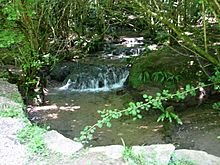Slade Brook facts for kids
| Site of Special Scientific Interest | |

Slade Brook showing tufa dams
|
|
| Area of Search | Gloucestershire |
|---|---|
| Coordinates | 51°44′49″N 2°37′56″W / 51.746945°N 2.632207°W |
| Interest | Biological/Geological |
| Area | 3.63 hectare |
| Notification | 2003 |
Slade Brook is a special natural area in Gloucestershire, England. It's called a Site of Special Scientific Interest (SSSI) because of its unique plants, animals, and geology. This important site was officially recognized in 2003. It covers about 3.63 hectares, which is roughly the size of five football fields.
Contents
Discovering Slade Brook's Special Habitat
Slade Brook is found in the beautiful Forest of Dean plateau and the Wye Valley Area of Outstanding Natural Beauty. What makes this stream so special is its active tufa formation. Tufa is a type of limestone that forms when minerals build up from water.
How Tufa Dams Form
The stream system at Slade Brook has many tufa dams. These are like natural steps or walls made of rock. Between these dams are small waterfalls called plunge pools and connecting stream parts. This amazing natural process happens because of both physical and chemical changes in the water.
The Journey of Water and Minerals
Slade Brook starts on the Carboniferous Limestone of the Forest of Dean. Rainwater soaks into cracks and holes in this limestone. As it travels, the water picks up dissolved calcium carbonate, a mineral found in limestone.
When this mineral-rich water comes out of springs along the brook, it loses carbon dioxide. This causes the calcium carbonate to turn solid and form deposits. Most of these deposits create the dam-like structures you see, which are made of tufa.
Nature's Helpers: Plants and Algae
Plants, such as twigs and branches, along with tiny algae and mosses, help this process. They slow down the stream's flow. Also, when plants do photosynthesis, they take carbon dioxide out of the water. This encourages even more calcium carbonate to form. The plants and other bits of nature then become the base where the tufa builds up.
Why Slade Brook's Tufa is Important
Slade Brook is very important because active tufa dams are quite rare. This site has about sixty of them! Studying these dams helps scientists understand how ancient tufa formations were created. It also helps them learn about how these natural structures are still forming today.
Animals Living in Slade Brook
Slade Brook is home to different kinds of animals. One special insect found here is the white-letter hairstreak butterfly. This butterfly is important to the local ecosystem.
Protecting Slade Brook
The site is carefully looked after to make sure its unique features are protected. In 2009, a group called Natural England reported that Slade Brook was in a good and healthy condition. This means the tufa dams are still forming, and the habitat is thriving.

